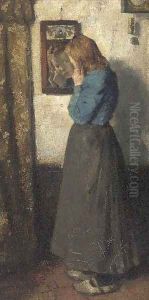Emanuel Samsom Van Beever Paintings
Emanuel Samson van Beever was a lesser-known Belgian artist whose life and work are not widely documented in the annals of art history. He was born in 1824 in a period where Belgium was experiencing significant political and cultural changes, having declared its independence from the Netherlands in 1830. Van Beever would have been a contemporary of the Belgian Romantic school, although his work does not feature prominently in discussions of the period.
Throughout his life, Van Beever would have witnessed Belgium's industrialization and the subsequent social changes. His art may reflect the transformation of the Belgian landscape and society, as the themes of industrialization and the experience of modernity were common among artists of this era.
Due to the scarcity of records on Van Beever, details about his training, the scope of his artistic production, and his impact on the art world are limited. It is possible that he was a regional artist, whose works were perhaps known and appreciated within a smaller community or specific patronage circles.
Van Beever died in 1912, before the outbreak of World War I, which would deeply affect Belgium and Europe. The lack of widespread recognition or detailed historical accounts of his work suggests that, unlike his contemporaries who may have achieved fame, such as James Ensor or Fernand Khnopff, Van Beever's artistic legacy did not have a lasting influence on subsequent generations of artists. His death marked the end of a life that remains enigmatic and largely obscured by time.
Notwithstanding the limited information, Van Beever’s existence is a reminder of the multitude of artists who lived, created, and contributed to their local art scenes without gaining international renown. Their stories, though less documented, are an integral part of the rich tapestry of art history.
